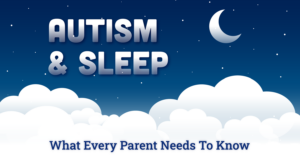The Importance of a Good Night’s Sleep
What does a good night’s sleep sound like to you? Do you try to get the recommended eight hours a night? Do you stay asleep undisturbed the whole time?
According to the CDC, Most of us aren’t getting the amount of sleep our bodies need. However, it’s more important than we realize – sleep provides many benefits outside of feeling well-rested, including:
-
A boosted immune system
-
Improved cognitive and motor skills
-
Lowered blood pressure
-
Increased attentiveness and memory
-
Reduced physical and mental stress both
-
Sped-up metabolism and muscle recovery
We are estimated to spend up to 33% of our lives sleeping. It’s a mandatory part of being human and something we must do daily or face some harsh consequences.
What Lack of Sleep can Mean for Your Health

A lack of sleep has the exact opposite effect of getting all the rest you need. Unfortunately, our bodies accumulate a “sleep debt” for up to six weeks. This means that a lack of sleep over time can have increasingly negative side effects on our physical and mental health. This can include:
-
Aggression or irritability
-
Depression or anxiety
-
Increased or regressed behavioral problems
-
Poor learning and cognitive performance
-
Slowed brain development and memory loss
-
Weight gain, a weakened immune system, and increased blood pressure
Do People with Autism Have Sleeping Issues?
According to Dr. Suzanne Goldman of Vanderbilt University; it is estimated that 48% of adults have trouble falling and staying asleep, while a staggering 80% of adults and children diagnosed with autism struggle to fall and stay asleep.
Goldman’s research continues to say that a neurotypical person can fall asleep in about 15 minutes, while those with ASD can take twice as long before they doze off. On average, they also experience 8% less time in REM sleep.
There have been a handful of studies into why children with autism struggle to sleep, all listing many different causes, but a consistent pattern of causes include:
-
Sensory sensitivities
-
The body not producing enough melatonin naturally
-
A poor diet or gastrointestinal problems
-
Anxiety, depression, or ADHD
-
Not enough physical activity throughout the day
-
Bedwetting
-
Nightmares or night terrors
-
Sleepwalking
Some sleep problems naturally go away after childhood with reassurance and patience. Night terrors, bed wetting, and sleepwalking are common in younger children and can often be outgrown over time with the right nurturing.
A widely held belief is a lack of recognizing social cues. Neurotypical people typically understand the cycles of light and dark and have a natural circadian rhythm that tells them that bedtime is approaching. However, seeing others brushing their teeth or getting into pajamas may be cues that get lost or misinterpreted by our friends with autism.
The most proven, easiest-to-do treatment plan is routine.
Making a Routine of Counting Sheep
Like many of the lessons taught through ABA therapy, consistency and routine are the foundation, and sleep is no exception. Getting into a routine puts us in a natural rhythm, and when it comes to falling asleep, it helps us unwind and ease into it.
The routine must follow a daily schedule and be a predictable and relatively short pattern of events. Picture the hour or so before going to bed; what is your routine? How can you recreate a similar routine for your child with autism?
There is the ‘getting ready for bed’ phase of putting on pajamas, brushing your teeth, and preparing for the morning’s routine. Even leading up to this is usually a routine of relaxing activities like reading, taking a bath, or listening to music. Find leisurely activities for your child that they can add to the “wind down” period just before getting into bed.
Pre-Bedtime Habits to Encourage Your Nightly Routine
Setting up a nightly ritual and following it is easier said than done, but with practice and patience, it’ll become a naturally occurring rhythm. Here are a few tips to cement the foundation of your new routine:
-
Have clear and consistent cues when bedtime is approaching. For example, an hour before bedtime, start quiet activities. Then, 15 minutes before bedtime, make it clear that it’s time to brush your teeth.
-
Remove stimulating distractions. This includes electronic devices, but also could involve black-out curtains to absorb light and sound, a comfortable blanket, or the room’s temperature.
-
Well-balanced meals. Having a healthy meal relatively close to bedtime so the child doesn’t go to sleep full or hungry. Make sure not to select anything sugary or caffeinated.
-
Visual supports showing the bedtime routine. Show your child visual representations of events in the routine and how to do them. This can be used as prompts and eventually faded. For example, putting on pajamas, brushing teeth, getting tucked into bed, reading a bedtime story, or turning the lights off.
-
Bedtime story. An extensive study has shown that reading books to children drastically improves cognitive and speech development and can be used as another great cue at bedtime.
-
Praising success. Put stickers on the visual schedule, high five, or speak kind words of approval.
-
Coach your child to fall asleep without you in the room. This is something you can slowly fade and can help ease your child into a regular sleep schedule. Start by lying with them or sitting near the bed as they fall asleep. Eventually, start pulling back and sitting outside the room until your child is comfortable enough to fall asleep completely on their own.
If your child refuses to sleep or wakes up during the night, quietly and calmly put them back into their own bed. Help them settle down and remind them of the sleep routine and its importance. You may need to repeat this a few times, but it should become less and less frequent with time.
Daytime habits to promote your nightly routine

Common sleep problems are caused by unhealthy eating habits and lack of physical activity throughout the day. You can easily sort out these obstacles with some simple lifestyle changes:
-
Physical activity of at least an hour of energetic play like walking, running, and jumping.
-
Well-balanced meals throughout the morning and afternoon.
-
Quick naps early in the day. No more than 20 minutes and not late in the afternoon.
-
Using the bed only at night. This sets the tone that lying in bed is a signal or cue for bedtime and furniture for sleeping.
If All Else Fails
If behavioral or routine changes aren’t solving the sleep problem, here are some more options to consider:
-
Tracking your child’s sleep with a sleep diary. Keeping a journal of your child’s sleep habits creates a retraceable history that reveals patterns over time of hours slept, number of interruptions, and any problems that may stem from diet, exercise, or a change in routine. This can also be a helpful record to bring to the attention of your child’s healthcare specialist.
-
White Noise Machines. By emitting a constant and consistent low-volume sound, they block out changes in noise, like a dog barking or creaky floors and doors. If your child does wake up, the sound might be soothing to them and ease them back to sleep. However, white noise may have the opposite effect on children that are hypersensitive to auditory stimuli, so it is important to understand your child’s sensory issues.
-
Using a scented humidifier at night. The sweet aroma of lavender misting into the air throughout the bedroom is a great and subtle bedtime cue. Lavender has been shown to promote calmness and wellness, reduce stress and promote relaxation.
-
Weighted blankets. While research has shown weighted blankets may be a placebo and had little to no change in sleep habits with children with autism – it was noticed to be favored over regular blankets when offered. A 1999 study did show signs of children with ASD finding deep pressure soothing.
-
Low doses of melatonin before bed. Over-the-counter products of 1-5mg can help gently ease and keep your child asleep throughout the night. A pediatrician might suggest melatonin if your child struggles to sleep. Studies have found that melatonin for children is both safe and effective, but this is a personal choice and something to discuss with a medical professional.
-
For extensive sleepwalkers, you can try sleepwalking alarms that trigger when the weight of the person leaves the bed; there are also bed rails and floor padding you can get for worst-case scenarios. Typically, children outgrow this by eight or twelve years old, but if this persists, seek help from a sleep specialist.
-
Talking to your pediatrician/sleep specialist in worse-case scenarios. In the event you aren’t making progress, parents should consult with their child’s pediatrician to investigate further causes. Medical conditions like sleep apnea, acid reflux, seizures, or some prescription medications can affect the quality of sleep. In extreme cases, a physician may order a sleep study to further investigate your child’s sleep patterns.
Just remember, your child’s journey with autism is as unique as they are, and so are their needs. Some approaches may help, and others may not. It’s a process of elimination that can take time until you find what works. Set goals, track your habits, and measure your success. This article is for informational purposes only and should not replace advice from your doctor or other medical professionals. Sweet dreams!
To learn more about our flexible and caring approach to ABA therapy at Applied ABC, click here.
Sources cited:
Worley, Susan. The Extraordinary Importance of Sleep
J Pediatr Neurosci. Autism and Sleep Disorders
Aminoff, Michael. We spend about one-third of our life either sleeping or attempting to do so
Goldman, Suzanne. Defining the sleep phenotype in children with autism
Gee, Bryan. Improving sleep quality using weighted blankets among young children with an autism spectrum disorder
Edelson, Stephen & Grandin, Temple. Behavioral and Physiological Effects of Deep Pressure on Children With Autism





